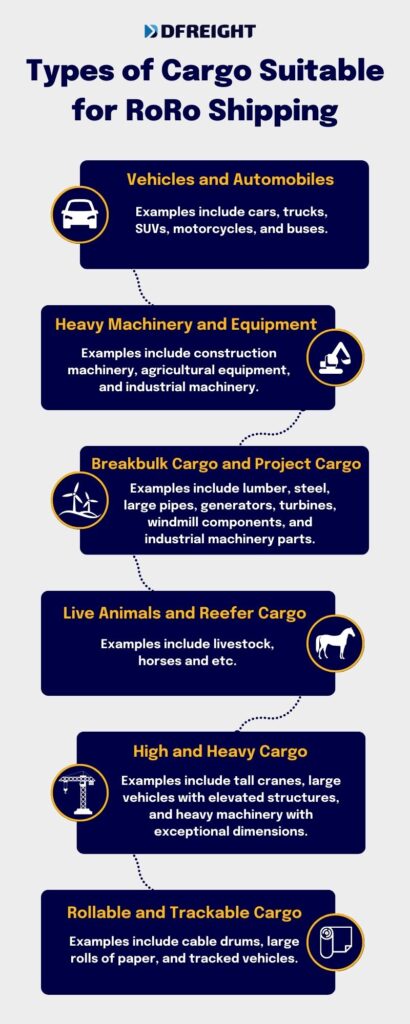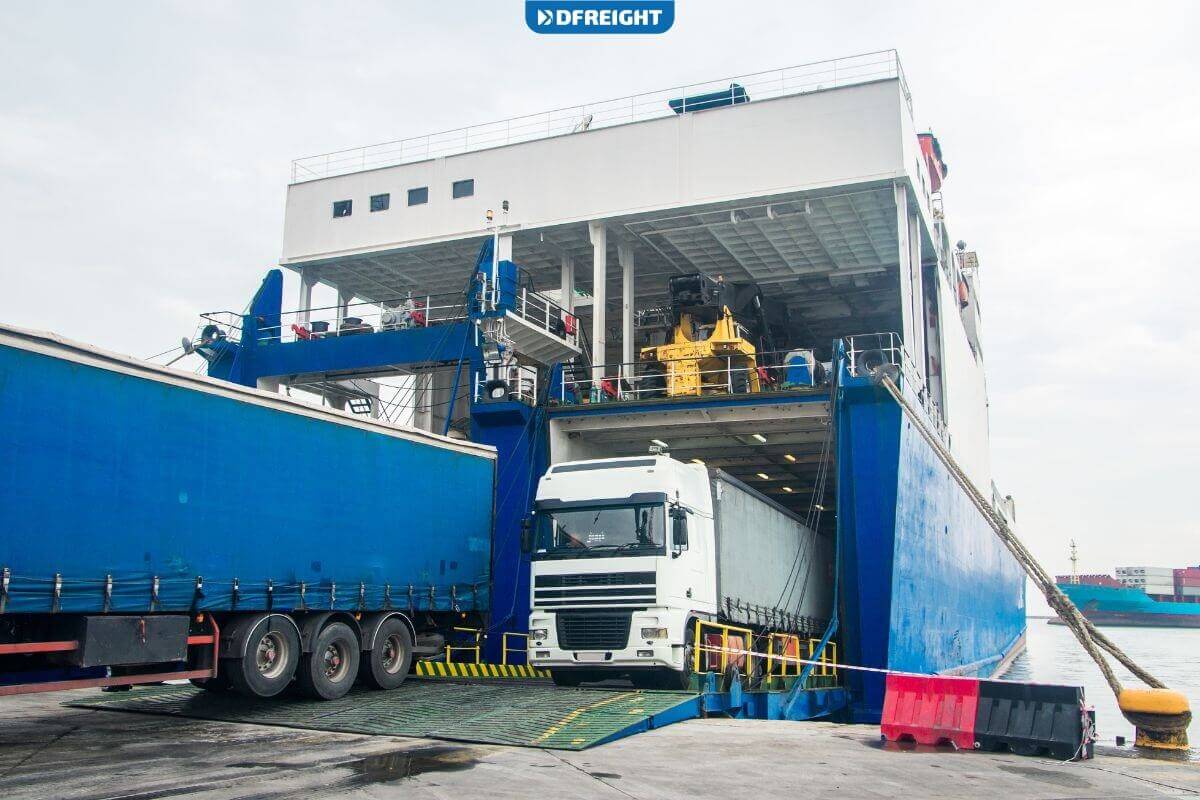RoRo, short for “Roll-on/Roll-off,” is a highly efficient method of transporting cargo and vehicles across the seas. It has become an integral part of the global logistics industry, facilitating the movement of a wide range of goods, from cars and heavy machinery to project cargo and even live animals. RoRo shipping is widely used due to its simplicity, cost-effectiveness, and ability to handle various types of cargo.
When it comes to Roll-on/Roll-off (RoRo) shipping, DFreight is your trusted partner. RoRo shipping offers a reliable, cost-effective method for transporting vehicles, heavy machinery, and oversized cargo. Our experts are well-versed in handling RoRo shipments, ensuring that your valuable assets are securely loaded and efficiently transported to their destination. Experience the simplicity of RoRo shipping with our expert handling of vehicles and oversized cargo.
Embark on a seamless journey through the world of Roll-on/Roll-off (RoRo) shipping with our comprehensive guide. Whether you’re a seasoned logistics professional seeking to expand your knowledge or a curious individual looking to understand the ins and outs of this innovative shipping method, our Ultimate Guide to RoRo Shipping is here to illuminate every aspect. This blog post is your passport to unlocking the potential of RoRo shipping and optimizing your cargo transport like never before. Let’s set sail and explore the boundless opportunities that await in the world of RoRo shipping!
Table of Contents
What is RoRo Shipping?
RoRo shipping is a specialized maritime transport method that allows cargo to be rolled onto and off a vessel using ramps or special facilities. Unlike traditional container shipping, where the shipment is packed into standardized containers and lifted onto the ship, RoRo vessels have open decks that accommodate various types of wheeled cargo. This means that cars, trucks, buses, construction equipment, and other similar items can be driven directly onto the ship, hence the name “Roll-on/Roll-off.”
How RoRo Ships Work
RoRo (Roll-on/Roll-off) ships are specialized vessels designed to transport wheeled cargo, such as cars, trucks, buses, heavy machinery, and other types of vehicles. They are equipped with unique features that allow cargo to be efficiently rolled onto and off the vessel, simplifying the loading and unloading processes compared to traditional container shipping. Understanding how RoRo ships work provides insight into the logistics behind this efficient mode of maritime transportation.
- Vessel Design and Configuration:
RoRo vessels are purpose-built to accommodate wheeled cargo. They feature large open decks with sturdy ramps at the ship’s bow (front) and stern (rear). These ramps can be adjusted to different heights to accommodate various types of vehicles and cargo. The open design allows vehicles to be driven directly onto the ship, making the loading process more straightforward.
- Loading and Securing Cargo:
The crew will lower the appropriate ramp to the dock level when loading cargo. Vehicles and machinery are then driven onto the ship, utilizing the “roll-on” aspect of RoRo shipping. Once on board, the cargo is securely parked and fastened to the ship’s deck to prevent movement during transit.
- Internal Arrangement:
Inside the RoRo vessel, the decks are organized to maximize cargo capacity and security of shipments. The decks may have multiple levels, and each vehicle is carefully positioned and lashed down to ensure stability. Crew members are responsible for strategically arranging the cargo to optimize space utilization and maintain a balanced load distribution.
- Safety Measures:
Safety is a top priority in RoRo shipping. Crew members receive training in handling and securing various types of cargo. Additionally, the ships are equipped with safety systems, such as fire suppression systems, watertight doors, and emergency evacuation procedures. The ship’s deck’s open design allows easy access to the cargo in case of emergencies.
- Unloading Process:
Upon reaching the destination port, the ship’s crew will begin unloading. The RoRo vessel will dock parallel to the pier, and the appropriate ramp will be lowered to match the dock’s level. Cargo is then driven off the vessel, utilizing the “roll-off” aspect of RoRo shipping. Efficient unloading processes allow quick turnaround times, reducing port congestion and facilitating timely deliveries.
- Specialized Facilities:
Some RoRo ships are equipped with additional facilities to handle specific cargo requirements. For instance, some vessels may have refrigerated sections to transport perishable goods, while others may have special equipment to operate oversized or heavy machinery.
- Port Infrastructure:
RoRo shipping relies on well-equipped ports with suitable infrastructure to efficiently accommodate the loading and unloading of wheeled cargo. RoRo terminals are equipped with ramps, dedicated parking spaces, and secure areas for cargo staging.
In conclusion, RoRo ships provide a highly efficient and cost-effective method for transporting wheeled cargo across the seas. Their specialized design, loading, and unloading processes, coupled with the ability to carry a diverse range of vehicles and equipment, make them a crucial component of the global logistics industry. By simplifying the shipping process and reducing turnaround times, RoRo vessels play a vital role in facilitating international trade and the smooth movement of goods worldwide.
Types of Cargo Suitable for RoRo Shipping
RoRo (Roll-on/Roll-off) shipping is a versatile and efficient mode of maritime transportation that can accommodate various types of cargo. While the primary focus of RoRo vessels is wheeled cargo like cars, trucks, and machinery, they can also handle other types of cargo that can be easily rolled onto and off the ship. Here are some of the common types of cargo suitable for RoRo shipping:

Vehicles and Automobiles: RoRo shipping is best known for transporting automobiles and other motor vehicles. Cars, trucks, SUVs, motorcycles, and buses are regularly shipped using RoRo vessels. The open decks and specially designed ramps allow vehicles to be easily driven onto and off the ship, making it an efficient and cost-effective option for automobile manufacturers and individuals relocating vehicles.
Heavy Machinery and Equipment: RoRo vessels can transport a wide range of heavy machinery and equipment, such as construction machinery (excavators, bulldozers, cranes), agricultural equipment (tractors, harvesters), and industrial machinery. Their large open decks and adjustable ramps can accommodate oversized and heavy cargo, simplifying the loading and unloading processes.
Breakbulk Cargo and Project Cargo: RoRo shipping is suitable for handling breakbulk cargo, which refers to non-containerized cargo that is too large or irregularly shaped to fit inside standard containers. Examples include lumber, steel, large pipes, generators, turbines, windmill components, and industrial machinery. RoRo vessels offer flexibility in handling cargo and can accommodate various shapes and sizes.
Live Animals and Reefer Cargo: Some RoRo vessels have facilities to transport live animals, such as livestock and horses, under controlled and humane conditions. Additionally, certain RoRo ships have refrigerated sections (reefer cargo) for transporting temperature-sensitive goods like fresh produce and pharmaceuticals.
High and Heavy Cargo: RoRo shipping is ideal for high and heavy cargo, which includes tall and heavy items that may not fit inside standard containers or other shipping methods. Examples include tall cranes, large vehicles with elevated structures, and heavy machinery with exceptional dimensions.
Rollable and Trackable Cargo: RoRo vessels can carry rollable and trackable cargo in addition to wheeled cargo. This includes cable drums, large rolls of paper, and tracked vehicles (e.g., tanks) that can be rolled or driven onto the ship.
It’s important to note that while RoRo shipping is suitable for many types of cargo, there are limitations. Cargo must be self-propelled, or it must be possible to load and unload it using suitable rolling equipment. Additionally, cargo must be adequately secured to ensure safety during transit. For specific delicate or sensitive cargo, other shipping methods, like container shipping, may be more suitable.
In conclusion, RoRo shipping offers a wide range of options for transporting different types of cargo. Its versatility, efficiency, and cost-effectiveness make it popular for industries and individuals seeking to move wheeled and rollable goods across the seas.
Advantages of RoRo Shipping
RoRo shipping offers several key advantages that have made it a preferred choice for transporting certain types of cargo:
- Efficiency: Loading and unloading processes are significantly faster and more streamlined than container shipping. This reduces port waiting times and enables quicker deliveries.
- Cost-effectiveness: RoRo shipping can be more cost-effective for large, heavy cargo or vehicles since it eliminates the need for specialized lifting equipment and container handling.
- Versatility: RoRo vessels can carry a wide range of cargo, from small cars to oversized machinery, making them suitable for diverse industries.
- Reduced Risk of Damage: With proper securing and stowage, RoRo shipping minimizes the risk of cargo damage during transit compared to other shipping methods.
- Environmentally Friendly: RoRo vessels generally have lower carbon footprints than airfreight and other shipping alternatives, making them a greener option.
Preparing Your Cargo for RoRo Shipping
Preparing your cargo for RoRo shipping is essential to ensure smooth and efficient transportation.
First and foremost, thoroughly clean and remove all personal items from the vehicles or machinery to comply with shipping regulations.
Secure the cargo for transport by removing loose parts and accessories, and ensure the fuel tank is adequately filled.
Properly document the cargo, including any required import and export paperwork, and comply with customs requirements of the departure and destination countries.
Additionally, consider purchasing insurance coverage for the cargo to safeguard against potential damages during transit.
By taking these necessary steps, you can help ensure that your cargo is ready for RoRo shipping and minimize any potential delays or issues during the shipping process.
Cost and Pricing in RoRo Shipping
Cost and pricing in RoRo shipping depend on factors influencing the overall expenses of transporting cargo via Roll-on/Roll-off vessels. The primary cost determinants include the cargo size and weight, the distance between the ports of origin and destination, the type of cargo being shipped, and the demand for RoRo shipping services at a given time.
Additionally, fuel prices and operational costs impact the pricing structure. RoRo shipping rates are typically calculated based on the cargo’s cubic meters, weight, or combination. It is essential to consider any additional fees or surcharges related to specialized equipment, customs clearance, insurance, and port handling charges.
Comparing quotes from various RoRo shipping providers and understanding the various cost components will help shippers make informed decisions to optimize the transportation of their cargo while managing expenses effectively.
Regulations and Compliance in RoRo Shipping
Regulations and compliance play a crucial role in RoRo shipping to ensure cargo’s safe and efficient transportation across international waters. RoRo shipping is subject to various international maritime laws and regulations, such as the International Convention for the Safety of Life at Sea (SOLAS) and the International Maritime Dangerous Goods (IMDG) Code. These regulations cover vessel safety, cargo stowage, securing procedures, and emergency response protocols.
Additionally, customs and import/export regulations of both the departure and destination countries must be followed. Compliance with environmental standards, such as preventing marine pollution, is also essential. RoRo shipping companies must maintain high standards in vessel maintenance, crew training, and safety protocols to meet regulatory requirements and ensure a responsible and sustainable shipping practice.
Shippers and carriers must work together to ensure full compliance with these regulations to safeguard the well-being of crew members, protect the environment, and facilitate smooth and lawful international trade.
Conclusion
In conclusion, RoRo shipping offers a highly efficient and versatile method for transporting a wide range of cargo, from vehicles and heavy machinery to breakbulk and project cargo. Its roll-on/roll-off design simplifies the loading and unloading, reducing turnaround times and enhancing cost-effectiveness. However, successful RoRo shipping requires careful preparation of the cargo, adherence to international regulations, and compliance with customs requirements.
As the industry continues to evolve and adopt technological advancements, RoRo shipping is expected to remain a vital component of the global logistics landscape, providing a reliable and sustainable solution for transporting goods across international waters.
What types of cargo can be transported using RoRo shipping?
RoRo shipping is suitable for a wide range of cargo, including vehicles, heavy machinery, breakbulk items, live animals, and reefer cargo. It can also handle high and heavy cargo, as well as rollable and trackable items.
How is RoRo shipping different from container shipping?
RoRo shipping involves rolling cargo onto and off the vessel using ramps, whereas container shipping uses standardized containers that are lifted on and off the ship with cranes. RoRo vessels are ideal for wheeled and oversized cargo, while container shipping is more versatile for general goods.
How are RoRo shipping rates calculated?
RoRo shipping rates are based on factors such as the size and weight of the cargo, the distance traveled, demand, and fuel costs. Rates are usually calculated based on the cargo’s cubic meters, weight, or a combination of both. Additional fees may apply for specialized equipment, insurance, and port handling charges.
Are there any safety measures in place for RoRo shipping?
Yes, RoRo shipping prioritizes safety. Vessels are equipped with safety systems, such as fire suppression and emergency evacuation procedures. Crew members undergo training in cargo securing and handling to ensure the safe transportation of goods.













